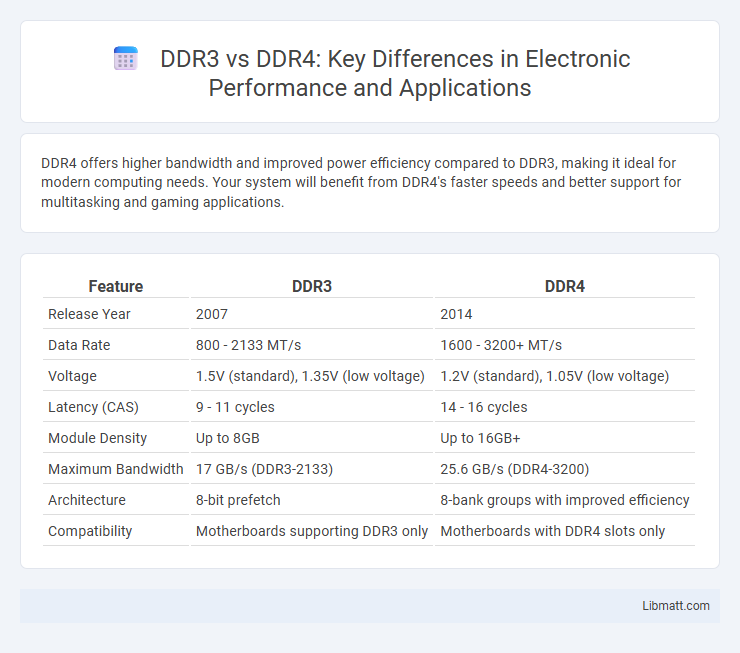DDR4 offers higher bandwidth and improved power efficiency compared to DDR3, making it ideal for modern computing needs. Your system will benefit from DDR4's faster speeds and better support for multitasking and gaming applications.
Table of Comparison
| Feature | DDR3 | DDR4 |
|---|---|---|
| Release Year | 2007 | 2014 |
| Data Rate | 800 - 2133 MT/s | 1600 - 3200+ MT/s |
| Voltage | 1.5V (standard), 1.35V (low voltage) | 1.2V (standard), 1.05V (low voltage) |
| Latency (CAS) | 9 - 11 cycles | 14 - 16 cycles |
| Module Density | Up to 8GB | Up to 16GB+ |
| Maximum Bandwidth | 17 GB/s (DDR3-2133) | 25.6 GB/s (DDR4-3200) |
| Architecture | 8-bit prefetch | 8-bank groups with improved efficiency |
| Compatibility | Motherboards supporting DDR3 only | Motherboards with DDR4 slots only |
Introduction to DDR3 and DDR4
DDR3 and DDR4 are types of synchronous dynamic random-access memory (SDRAM) widely used in computer systems, with DDR4 being the successor to DDR3. DDR4 offers higher data transfer rates, increased bandwidth, and improved energy efficiency compared to DDR3, making it suitable for modern computing needs. Key specifications such as clock speed range, voltage requirements, and latency differ between DDR3 and DDR4, impacting overall system performance and power consumption.
Key Differences Between DDR3 and DDR4
DDR4 memory offers higher data transfer rates and increased bandwidth compared to DDR3, with speeds ranging from 2133 MT/s to over 3200 MT/s versus DDR3's typical 800 MT/s to 2133 MT/s. DDR4 operates at a lower voltage of 1.2V, enhancing energy efficiency and reducing heat output compared to DDR3's 1.5V or 1.65V. The architectural improvements in DDR4 include increased module density, allowing for higher memory capacity per DIMM, and improved latency performance relative to DDR3.
Performance Comparison: DDR3 vs DDR4
DDR4 memory offers significantly higher data transfer rates, typically ranging from 2133 MT/s to 3200 MT/s and beyond, compared to DDR3's maximum speeds around 1600 MT/s. DDR4 also operates at lower voltages (1.2V vs. 1.5V for DDR3), improving energy efficiency while enhancing overall system performance. Latency in DDR4 tends to be slightly higher, but the gains in bandwidth and power savings result in better real-world performance for modern applications and gaming.
Memory Speed and Bandwidth
DDR4 memory offers significantly higher speeds and bandwidth compared to DDR3, with typical frequencies starting around 2133 MHz and scaling up to 3200 MHz or more, whereas DDR3 commonly ranges between 800 MHz and 1600 MHz. The increased data transfer rates in DDR4 improve overall system performance, especially in tasks involving large data sets or multitasking. Your system benefits from faster data access and enhanced bandwidth when upgrading from DDR3 to DDR4, resulting in smoother and more efficient computing experiences.
Power Consumption and Efficiency
DDR4 memory modules offer significantly lower power consumption compared to DDR3, operating at 1.2V rather than DDR3's 1.5V or 1.35V for low-voltage variants, which translates to improved energy efficiency and reduced heat output. This power efficiency in DDR4 enhances overall system performance, especially in laptops and data centers where energy savings are crucial. Choosing DDR4 for Your system ensures better power management and longer battery life.
Compatibility with Motherboards and CPUs
DDR3 memory is compatible with older motherboards and CPUs that support its 1.5V or 1.35V voltage standards and uses a 240-pin DIMM configuration. DDR4 requires newer motherboard chipsets and CPUs designed for its lower 1.2V voltage and has a 288-pin DIMM layout, making it physically and electrically incompatible with DDR3 slots. Ensuring motherboard and CPU support for the specific DDR generation is vital for system stability and performance.
Capacity and Scalability
DDR4 memory offers significantly higher capacity per module compared to DDR3, supporting up to 64GB or more, whereas DDR3 typically maxes out around 16GB per module. Scalability in DDR4 is enhanced by improved architecture and higher module density, enabling more memory channels and thus larger total memory configurations suitable for advanced computing tasks. These advancements make DDR4 preferable for systems requiring extensive multitasking, virtualization, and large-scale data processing.
Pricing and Availability
DDR4 memory typically comes at a higher price point compared to DDR3 due to its improved performance and efficiency, though prices have been steadily decreasing as DDR4 becomes the standard. DDR3 remains widely available, especially in older or budget systems, making it a cost-effective option for upgrading older computers. Your choice may depend on balancing cost with the availability of compatible motherboards and the performance needs of your system.
Gaming and Productivity Benchmarks
DDR4 memory delivers higher clock speeds and improved bandwidth compared to DDR3, resulting in better gaming frame rates and smoother multitasking performance in productivity benchmarks. Gamers experience reduced loading times and increased FPS in titles optimized for faster memory, while productivity applications like video editing and 3D rendering benefit from DDR4's enhanced data transfer speeds. Benchmark tests consistently show DDR4 outperforming DDR3, with gains ranging from 10% to 30% depending on the specific workload and system configuration.
Which Should You Choose: DDR3 or DDR4?
DDR4 offers faster speeds, improved power efficiency, and higher transfer rates compared to DDR3, making it ideal for modern systems requiring better performance and multitasking capabilities. DDR3 might still be suitable for budget-conscious users or older systems where upgrading the motherboard is not an option. Your choice should consider compatibility with your current hardware and the performance benefits needed for your specific applications.
DDR3 vs DDR4 Infographic

 libmatt.com
libmatt.com